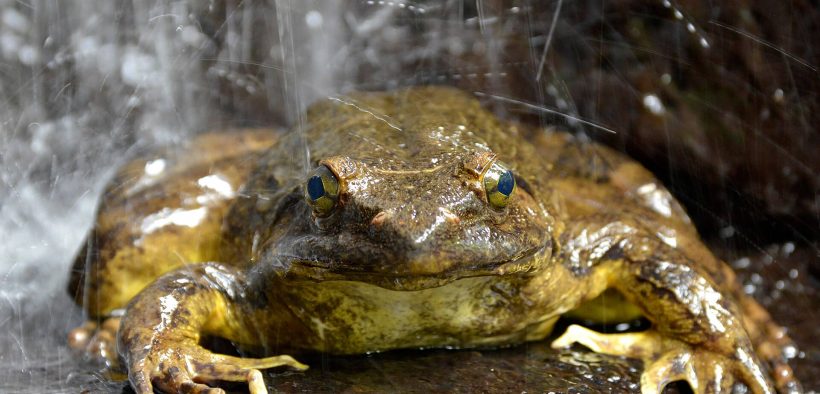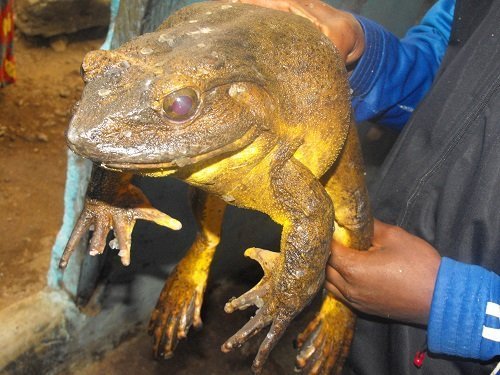Meet the Endangered Goliath Frogs of Africa that are Larger Than Chickens

There are several species of frogs in the world all ranging in size and characteristics, but the largest of them all in size are the “goliath frogs”, which – wait for it, are larger than most mature chickens! Sadly, the goliath frog is now an endangered species just like the northern white rhino.
The goliath frog, which is also known as the “goliath bullfrog”, is the largest frog in the world and can weigh up to 7.2 lbs. From the snout to the vent, the goliath frog can grow up to 33cm (slightly over one foot) long, that is excluding the legs which when stretched can go up to 30cm as well.
The goliath frogs distinctive size and features that make them appealing to humans for prize, pet and even food. Their eyes are about 2.5cm wide which is larger than the average eye size of most healthy humans. The frogs can live up to 15 years while in their natural habitat and up to 21 years in zoos but are now being acquired as pets by some people.

Goliath frog. (Photo: The Rufford Foundation)
The species’ natural habitat is in Cameroon and Equatorial Guinea and in a particularly small habitat range. As a result, their population is quickly dwindling due to habitat destruction and poaching from humans. They are often hunted at night where the poachers carrying a torch and armed with a gun shine the torch around to spot them by their eyes before shooting them.
Goliath tadpoles feed on a single species of an aquatic plant which is found only near waterfalls and rapids. Ecologists have used this behavior to try to explain why the goliath frogs have such a small habitat range. Mature goliath frogs feed on mice, spiders, crabs, smaller frogs, snakes and even bats.
The daunting size and weight of the goliath bullfrogs has made them an easy target for food by locals. Locals living near the frog’s habitat hunt them with the intention of eating them or exporting them as pets in a well-established pet trade in the region. Many goliath frogs are exported to the U.S. for participation in frog jumping contests too. This has had a great impact on their population, causing the International Union for Conservation of Nature (IUCN) to call for urgent conservation measures to save the goliath frogs from extinction. The IUCN currently classifies the species as threatened and on its Red List.
Though goliath frogs in zoos have a longer lifespan, they have been shown to be shy and inactive making it difficult to breed them which in turn affects their population.
In addition to threats from poaching and habitat destruction, goliath frogs now face a deadly pathogenic chytrid fungus which has caused fatal fungal infections. This also has led to a significant drop in their population.
The decline in population led to the government of Equatorial Guinea limiting their exportation to only a maximum of 300 frogs per year.
Scientists believe goliath frogs have been around for over 250 million years. One organization, the Rufford Foundation is working to save the goliath frog by protecting its natural habitat and raising awareness among locals.
To learn more about the Rufford Foundations work to save the goliath frog click here.
















asfor Marianne, I know